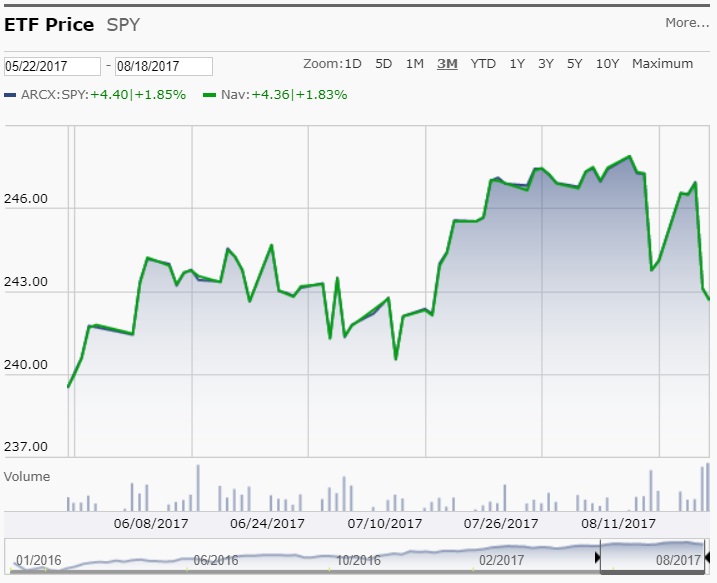Don't Fear The Market Decline - It's Normal
The stock market, as measured by the S&P 500, has seen a decline in the past couple weeks. The drop has media articles warning of what this could mean, with almost unanimously ominous headlines including:
- "Washington's mounting woes push S&P to biggest loss in three months" (Reuters)
- Wow! Three whole months! Does that mean I'm a vegetarian since I had a banana for breakfast?
- "Cracks surface in the bull trend, S&P 500 re-violates the breakout point" (MarketWatch)
- "Re-violates"...really? Is the S&P a felon on parole?
- "The S&P 500 is Flashing a Major Warning Signal" (Investopedia)
- The warning was probably court-mandated after the S&P violated that poor breakout point.
So are these articles, and the mid-August "plunge," signs you should pull out of the stock market; or is the news media a collective chicken little warning the sky is falling?
The answer can most easily be seen looking at the following 4 charts of the SPY ETF, which mirrors the S&P 500. Each point in the SPY ETF equates to 10 points in the S&P 500 index. So when the S&P 500 is at 2,400 the SPY will sit at 240.
Chart 1 - The "Plunge"
S&P 500 SPIDER ETF 7/20/2017 to 8/18/2017 from Morningstar.com
What has the media all hot and bothered is the 'giant' drop in the value of the S&P 500 over the past two weeks, as can be seen in this chart. So what constitutes a 'giant' drop? The S&P fell over 50 points from 2,481 to 2,425 (rounded to the nearest point). If you were 100% invested in the stock market, you would have lost 2.37% of your money.
No, that wasn't a typo, the drop was less than two and a half percent. If you can't stomach a 2.5% drop in your investments over a month, you probably shouldn't be invested in the stock market.
Of course, if you are the normal stock investor, a 2.5% drop should be well within the realm of your expectations.
Chart 2 - Simply a Return of Some Gains
S&P 500 SPIDER ETF 5/22/2017 to 8/18/2017 from Morningstar.com
To gain some perspective, let's pull back a little and look at how the last weeks' declines stack up against the previous three months.
In looking at the past three months, it appears this plunge is actually simply giving back some of the gains the market has had over the past few months.
The market began the 3-month period just shy of 2,400 points and has ended it just shy of 2,430 points. It's actually up a little over 1% for the last few months.
All of a sudden, the decline in the market doesn't seem so ominous.
Chart 3 - A Loss of Plus 10%
S&P 500 SPIDER ETF 8/22/2016 to 8/18/2017 from Morningstar.com
But investing isn't just about the past three months. The real question is how do these losses stack up over the past year. If you had stayed invested in the stock market over the past 12 months, the losses of the last couple weeks would have left you with a GAIN of 10.22%.
Overall, the market has been very good to investors this year, even with the recent drop in the value.
If you find an pundit wanting to be dire, you might read an article equating the 2.5% loss as a 61% annualized loss. This calculation assumes the losses of the past two weeks will continue at 2.5% every two weeks for the next year. Aside from the obvious absurdity of such a consistent market return, drops of that magnitude are exceedingly rare.
But what if the recent pull back of the market is actually a harbinger of a broader bear market to come?
Chart 4 - What If This is a Sign of a Market Crash
The previous charts should by no means suggest I am predicting market gains for the next year, or even for the rest of this year. Bear markets have and will continue to hit investors, even when the time leading up to the losses looks overwhelmingly positive (think 1999 and 2006).
The question of a market downturn isn't a matter of if, but a matter of when. The recent decline in the market, although minor, could be nothing or it could very well be the beginning of a market crash. The reality is, no one knows.
S&P 500 SPIDER ETF 1/22/1993 to 8/18/2017 from Morningstar.com
The good news, though, is it doesn't matter which of the two is correct. The money you have invested in the stock market should be invested for 5 years or more. This means if a bear market does come, you'll have plenty of time for the market to rebound. (I also have my advice on how to deal with a bear market).
Looking at the chart of the S&P 500 over the past 25 years, you should be able to see one trend emerge. What goes down also comes back up.
The chart includes both of the last major market crashes, including the tech bust of 2000 and the global financial crisis of 2008. In both cases, what happened next was a significant increase in stock prices. A similar trend can be seen if you look at the stock market over the past 90 years.
Keep Invested and Hold On
The stock market is compared to a roller coaster for a reason. Don't let a few weeks' drop (or even a market crash) scare you into pulling out of investing in the market. If stocks are the appropriate investment for you, then a market crash just means you have an amazing buying opportunity.
Take the Purposeful Finance Challenge
In just a few minutes a week, you can move toward financial independence. Each week you will receive a simple action item to take to improve your financial situation. Visit our challenge page and commit to build your financial plan one week at a time.
Joshua Escalante Troesh is a tenured professor of Business at El Camino College and the founder of Purposeful Finance. His career provides him with a unique insight on personal financial, having been a VP at a financial institution leading up to 2008, and involved with technology and internet stock research leading up to 2000. He can be reached for comment at info@purposefulfinance.org





